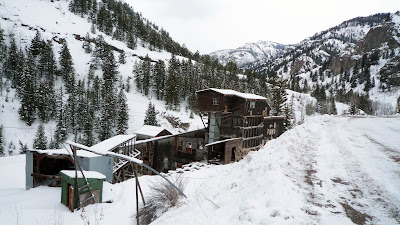 |
| 6/6/2013Colorado Art Ranch, Executive Director, Grant Pound. At the Ute Ulay Silver Mine, Lake City, Co. |
BY Ryan Mudgett
| Before the gold and silver discoveries in 1860’s and the rush in the 1880’s, mountain landscapes had minimal threat to them and flourished in a most natural state. Many hard rock discoveries brought a diverse array of people into some of the most remote yet breathtaking landscapes which normally wouldn't be inhabited. Now outdoorsy folk spend countless weekends in towns like Lake City CO, hiking 14ers, fly fishing, backcountry skiing, or prospecting mining history from the locals in still standing false front saloons. The mining legacy in Lake City left an exuberant past of mixed heritage including folklore, exploration, and unfortunately an environmental concern teetering on the edge of catastrophe.  |
Three miles west of Lake City, the Ute Ulay mill site still stands respectfully along the tourist 4x4 favorite, The Alpine Loop Scenic Byway. Adjacent to the site is the city’s water supply, Henson Creek, nestled in some of the most stunning glaciated landscapes in the state. The mill was hydroelectrically powered by Henson Creek until the Hidden Treasure dam just below the Ute Ulay burst in 1973, causing a metallic soup to wash downstream resulting in a complete kill of all macro invertebrates and fish 14 miles downstream. After this cataclysm, the people of Lake City became more environmentally aware of how these mines can impact their livelihood. Only to remind them of this fact in the winter of 2011 Grant Pound, Executive Director of Colorado Art Ranch stumbled upon an avalanche which plugged up Henson Creek just above the mill site. The avalanche blocked the river creating an ice dam which held back water up stream 35ft deep. Talk about an environmental disaster waiting to happen, and an eye widening moment for the town of Lake City. This avalanche became an immediate reminder of the Mill Dam failure that happened in 1973. Frightened at what this could do to the town and environment, city officials scurried to plan on what to do with the people of Lake City, and contacted specialist for advice so another flooding event didn't happen again. At risk the already super saturated tailing ponds, (mine waste) sat uneasily below the ice wall as people thought of using TNT to deal with the avalanche that threatened Lake City. Thankfully the town’s water supply elegantly bored a hole through the ice mass, and slowly leaked 35 feet of water that was backed up into a normal flow and the town, macro invertebrates, and fish were at ease. This taught the city that you cannot always plan for uncertainties, and showed everyone personally what potentially could have happened.This type of uncertainty is exactly what got the EPA’s attention and resulted in an emergency response remediation of the site that started on June 5th, 2013. The EPA hopes to be finished with remediation securing mine tailings by the end of summer 2013.
On June 6th, 2013 Lake City held the ceremony “Diggin’ In at the Ute Ulay”. The Diggin’ ceremony brought a diverse group of people together who were involved with the remediation and the future of the Ute Ulay mine site. After enjoying local coffee and donuts, Hinsdale County Commissioner Stan Whinnery gave a speech addressing the importance of the remedial action by the EPA, and the unique partnerships of local government, private (publically-held) mining company, non-profit organizations, and state and federal agencies, that worked together to secure the future of the mine and watershed. The EPA’s emergency response team became involved just in time when LKA Gold Incorporated donated the historic Ute-Ulay Town & Mill Sites to the County of Hinsdale. By transferring ownership of the 285 acre Ute Ulay allowed the county and town of Lake City to begin immediate restoration on Ute Ulay mining camps and initiated the EPA’s cleanup process involving the stabilization of the tailings ponds that are an extreme hazard to Henson Creek.
This type of complex remedial action started with envisioning what the future uses for the Ute Ulay Mine and Town site could be, when Grant Pound and DIRT's Executive Director, Kristie Borchers began discussing how art and mining could possibly mesh about 5 years ago. In 2011 Colorado Art Ranch created a transdisciplinary collaboration that included 7 artists and 7 scientists that were selected for the Lake City Artposium & Artist Residency. These artists and scientists not only inspired the community of Lake City but gave them a sense of ownership for the future of the Ute Ulay mine. Since the Hardrock Revision, it seems the mine that made Lake City is on the road to recovery, and things are really moving along in a holistic manner.








